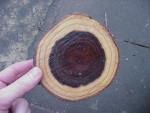
Properties of Timber - Laburnum
The Laburnum (Cytisus) does not appear to be much cultivated in England as a timber tree, as its merits deserve. There are about thirty species of Cytisus, but the common laburnum is the one most valuable.
In England it is cultivated principally as an ornamental shrub, and when in bloom its long branches of yellow flowers have a very showy appearance. It is however very useful as a tree, and wherever very hard and compact timber is required in small pieces, there are few superior to it.
The Romans reckoned it next to ebony. Although it is not so hard, or perfectly free from grain, it is much more tough and elastic. Its natural colour, too, is good, and it may be rendered almost black by lime water. It is also a very hardy tree, and will grow in almost any soil. It is susceptible to rabbits and hares when young.
Even though it never gets very big it is used for many purposes: wedges, pulleys, the handles of knives and other instruments.
When of larger dimensions, no timber is fitter for cabinet work of all kinds. It takes a fine polish, it looks well, and is durable. Chairs made of it are far stronger than any of mahogany. It may, however, be doubted whether laburnum holds glue as well, because it contains an oil which never dries out, and it is harder to work than mahogany.
This oily property fits it well for pins of blocks, and cogs in mill-work, as its oily nature prevents it from being abraded.
Many of the purposes for which it was once used are now supplied by lignum vitae, which is a harder wood, and even more oily, but lignum vitae is more splintery.
For tables, laburnum is not so well adapted, being seldom of sufficient width for a fold, and not standing well when glued, but for pillars, bed-posts, feet of tables and all similar uses, it is excellent.
Laburnum seeds are a powerful poison, and a garland of laburnum flowers, if worn for some time, is said to give headaches. Some of the largest trees we have seen are in Athol, by the wayside between Dunkeld and Blair.
 .....
.....
summarised from "The Library of Entertaining Knowledge - Timber trees" (1829), pub. Charles Knight, Pall Mall. Photograph © habitat21 website.
ND, habitat21
big turbines
small turbines